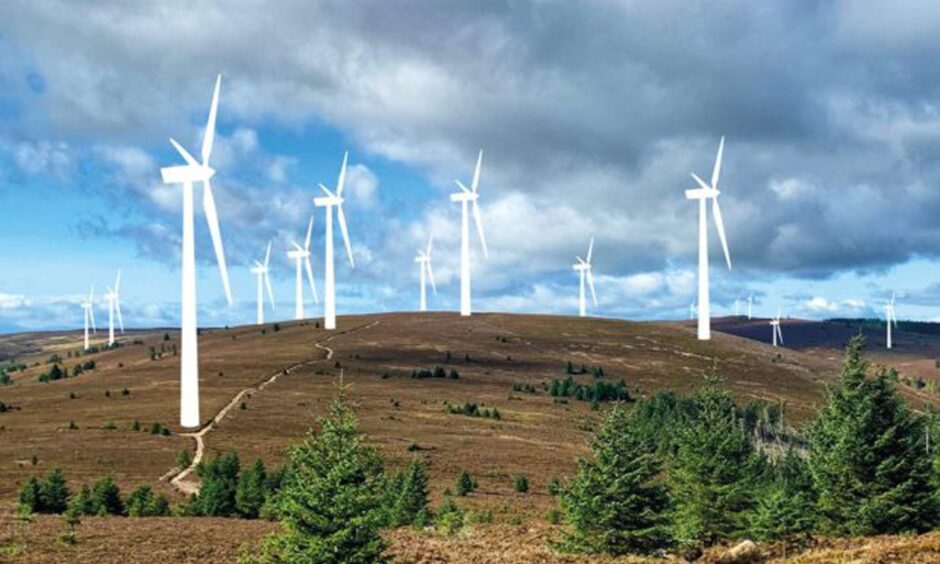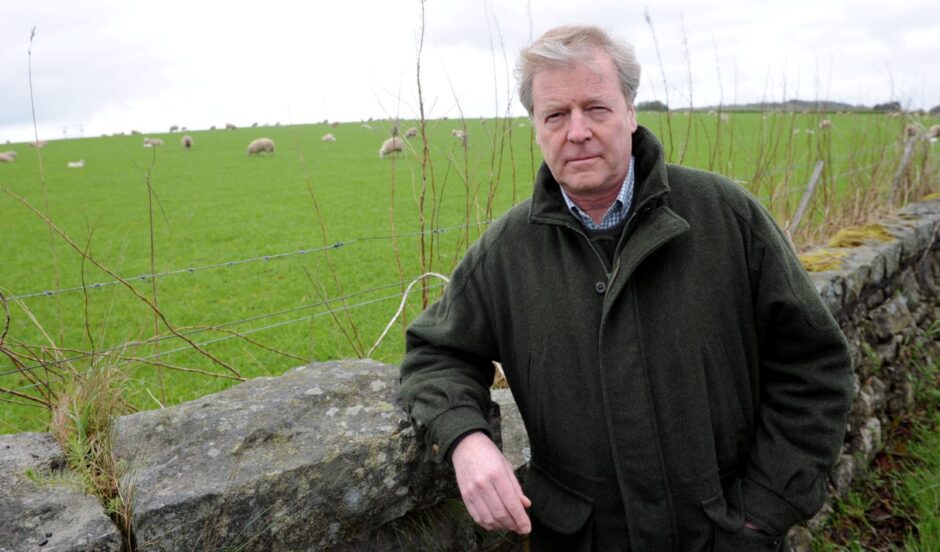
A community group fighting plans for the UK’s tallest wind farm on Royal Deeside has launched a new campaign, NaeFare, to help its cause.
The 16-turbine development is proposed for Hill of Fare near Banchory.
Nearly three-quarters (71%) of people who took part in a public consultation last year were either against the project or undecided.
Developer RES subsequently changed its plans – scaling the proposed development back from 17 towering turbines up to 820ft tall to 16 machines of either 590ft or 656ft.
Biggest turbines taller than six Kelpies stacked up
Objectors have pointed out the turbines will still be 10 times as tall as the Angel of The North statue.
And they will be more than three times the height of the Scott Monument in Edinburgh.
For further comparisons, they will be higher than six Kelpies statues balanced on top of each other, and more than twice the height of the Statue of Liberty or Big Ben.
It is reckoned they will be visible all the way to the Moray coast.
Midmar resident David Smith, spokesman for the NaeFare campaign, said: “These monster turbines will be set atop the Hill of Fare, which stands 460m (more than 1,500ft) above sea level.
“They will blight the landscape for miles and for many communities.”
Mr Smith described the group behind NaeFare as a “passionate community of individuals“, living locally and “dedicated to safeguarding the Hill of Fare and its stunning surroundings”.
Who owns the land at Hill of Fare?
RES is developing the wind farm in partnership with landowner Dunecht Estates.
The project’s website, hilloffare-windfarm.co.uk, says the site was chosen for a number of reasons. These include it being recognised as a suitable location for a wind farm, subject to “detailed consideration”, in the local development plan.
It is estimated the turbines would generate energy for more than 100,000 homes.
Dunecht is of the largest private estates in Aberdeenshire. It is owned by Charles Pearson, who splits his time between homes in West Sussex and Aberdeenshire.
Mr Smith said: “We believe in the importance of responsible, sustainable energy generation but are deeply concerned about the potential negative impact of the proposed wind turbines on this unique and unspoiled natural habitat.”
As well as the impact on the natural environment, NaeFare campaigners have concerns about noise and vibration disturbance, as well as “visual flicker” for those living nearby.
They will blight the landscape for miles and for many communities.”
David Smith, of the NaeFare campaign
The wind farm would be in an area with a higher population than similar projects elsewhere in the UK, the group said. Businesses, farms and more than 120 homes depend on the hill for their water supply, it added.
A statement launching the NaeFare campaign said: “Not only will these wind turbines be imposed on those living in the area by an absentee landlord who lives in the south-east of England, but they would be directly against the Aberdeenshire plan to reserve this location for domestic scale renewables.
“The Hill of Fare wind factory would serve only the purposes of George Pearson, Dunecht Estates and RES.
“The impact on the local population would be chaos and distress.”
Construction concerns
Construction work for new access roads would mean “constant heavy vehicle traffic, massive concrete-filled foundations and battery storage on the hillside,” the statement said.
It added: “Valuable animal habitats, heritage sites and peat bogs will be lost forever.”
The NaeFare campaign aims to “provide the information which local people need to object to the development effectively”. A new website, www.naefare.com, offers a “step-by-step process for helping people to submit objections online”.
Formal objections can be made on “material considerations” such as the visual impact on the landscape, environmental destruction, local population nuisance, private water supplies, or if the scheme contravenes Aberdeenshire Council’s local development plan.
The NaeFare group urged objectors to also make their views known to councillors.
Mr Smith added: “This development will give no incremental benefit and will rip the heart from a place of natural beauty forever.
Surely these turbines belong offshore rather than blighting the lives of Aberdeenshire residents?”
Gavin Shirley, RES
Hill of Fare wind farm project manager Gavin Shirley said: “As a responsible developer, with more than 40 years’ experience in developing onshore wind, we take great care in designing projects to ensure that we minimise any potential impacts and maximise the benefits for the local area.
“Community engagement is a fundamental part of this process and we have undertaken extensive consultation, including eight public events in the local area over the last year, to inform the final design.
“The proposal lies in an area identified by Aberdeenshire Council as having ‘potential for wind farm development’ and lies outwith any landscape or cultural heritage designations.
+1700 climate leaders have signed a letter to achieve a historic outcome at #COP28. Together we stand in support of delivering a 1.5°C aligned plan. Parties, it’s time for you to prove to us which side of history you are on. #LaterIsTooLate. https://t.co/zN1NGaYcut pic.twitter.com/xpMtdJ8m8D
— RES (@RESGroup) December 11, 2023
“We have also carried out detailed technical and environmental survey work over several years to ensure the project design protects habitats and wildlife.
“The modern turbines proposed are comparable in height to other consented projects across the country, including in Aberdeenshire.”
Mr Shirley added: “Projects like Hill of Fare wind farm are crucial for helping to tackle the climate emergency, delivering low-cost renewable electricity for consumers and for enhancing our security of supply.”
According to Mr Pearson, Hill of Fare could deliver about £66 million of economic activity linked to operations and maintenance, plus £14m of inward investment in the local economy.
‘Significant community benefit’
The landowner added: “During the wind farm’s lifetime it’s forecast that around £50m will be payable to Aberdeenshire Council in business rates.
“If approved, there will be significant community benefit, with RES proposing a tailored package that will be worth more than £26m to the local area over the project’s lifetime.
“Other benefits that will arise include much improved public access for walkers, mountain bikes and equestrian users via an enhanced network of tracks across the hill.”
Mr Pearson continued: “The estate will also work with RES in relation to the delivery of a biodiversity enhancement management plan.
“Commercial revenues from the wind farm will help meet the ongoing challenge of maintaining and improving the natural environment, built assets and businesses across Dunecht Estates as well as facilitating investment in new projects and jobs.
“Ultimately, as with any form of development, a wind farm on the Hill of Fare will only proceed if approved by the regulatory authority.”
Recommended for you

 © Supplied by DCT Graphics
© Supplied by DCT Graphics © Supplied by Tricker PR
© Supplied by Tricker PR © Supplied by Tricker PR
© Supplied by Tricker PR